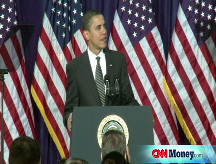Spend! Cut! Obama's budget dilemma
Obama's budget czar, Peter Orszag, has a tough job: Control spending in the long run as the U.S. commits unlimited dollars to rescue efforts in the near term.
NEW YORK (CNNMoney.com) -- If you're looking for Peter Orszag, you might check between a rock and a hard place.
As director of the White House Office of Management and Budget, Orszag is charged with a seemingly impossible task: Figure out how to rein in the more than $3.5 trillion federal budget as the country tries to spend its way out of a fiscal mess.
The country will get a glimpse of Orszag's handiwork next week when President Obama presents Congress with an outline of his fiscal year 2010 budget request.
That outline will be the first formal indication of the president's policy priorities going forward -- what tax policy changes he favors, what programs he wants to expand or eliminate, and how he wants to handle the long-term funding shortfalls for Medicare and Social Security. The White House is expected to submit its full budget request in March.
Orszag, who used to run the Congressional Budget Office, is the man Obama promised would "scrub" the budget to save money and set the country on a more fiscally sustainable course.
There's just one problem, however. Politically and practically, Orszag's task is a little like trying to scale an ice-coated cliff with flip-flops. And that's true even in good times.
"It's not as easy as it sounds. Every president tries to [scrub the budget]. But there's not much low-hanging fruit," said Charles Konigsberg, a former assistant director at OMB in the Clinton administration and now chief budget counsel at the Concord Coalition, a deficit watchdog group.
Here's what Konigsberg means: Roughly two-thirds of the federal budget -- about $2 trillion in 2008 -- is considered mandatory spending. That's money that Uncle Sam has committed to pay out in entitlement programs such as Social Security and Medicare, in interest owed on the national debt, and on other programs for which budget authority is written in stone.
The other third -- about $1 trillion -- is considered discretionary spending. That's money Congress decides on annually through appropriations bills. But even here lawmakers don't have as much flexibility as the word "discretionary" implies. Usually more than half is spent on security efforts such as defense.
Defense funding is driven in part by the geopolitical situation, but there are also increases baked into the cake. For instance, Konigsberg said, defense spending will go up for the next few years because in 2007 Congress agreed to a permanent build-up in military strength over five years. Plus, health care costs to cover military personnel will go up just as they do for everyone else.
And that's the budget picture in a good year. But 2008 and 2009 have been anything but. Add to the mandatory and discretionary mix the $2.1 trillion-and-counting that has been committed to rescue the banks and credit markets, the auto industry, the housing market and financially strained Americans and businesses.
In fact, largely because of the recession and the federal rescue efforts, the deficit will average at least $1 trillion per year for the next 10 years, even if stimulus is limited to two years and the jobs picture improves dramatically, according to estimates by economists Alan Auerbach of the University of California in Berkeley and William Gale of the Brookings Institution.
Another fiscal fly in the ointment: coming to grips with the fact that the long-term deficit is bigger than it appears to be.
There are a lot of ways the true cost of tax relief may be masked. For instance, every year lawmakers pass a "patch" to protect the middle class from having to pay the Alternative Minimum Tax. There's bipartisan support for repealing the tax, but budget projections always assume there won't be any patch and that the AMT will bring in more and more revenue as the years go on. That makes the long-term deficit seem smaller than it will be.
To repeal the AMT outright would cost an estimated $1 trillion.
White House spokesman Robert Gibbs on Friday promised that the outline of the president's budget request will bring "some honesty in budgeting to give people a fuller picture of what's going on ... [F]or many years we've used tricks and gimmicks to mask the size of our irresponsibility."
Many economists have said the deficit picture could be much worse if the government didn't do anything. But even so, the reality today is that Orszag and the White House are seriously constrained in what they can do to achieve Obama's policy aims while not worsening the financial outlook.
"There's never been a year like this before when there's so much happening at once. It's the most complicated fiscal mess," Konigsberg said.
Obama has said repeatedly he gets it, and he wants to fix it.
"While we need to do everything in the short-term to get our economy moving again, we must recognize that having inherited a trillion-dollar deficit, we need to begin restoring fiscal discipline and taming our exploding deficits over the long-term," the president said before signing the economic recovery package into law.
At the same time, he's also expressed a desire to do a number of very costly things -- such as making permanent the new Making Work Pay tax credit -- and reforming health care to the tune of $1.6 trillion over 10 years.
Of course, what Obama wants may not be what he gets.
"Congress never blindly accepts the president's budget request," Konigsberg said. ![]()




